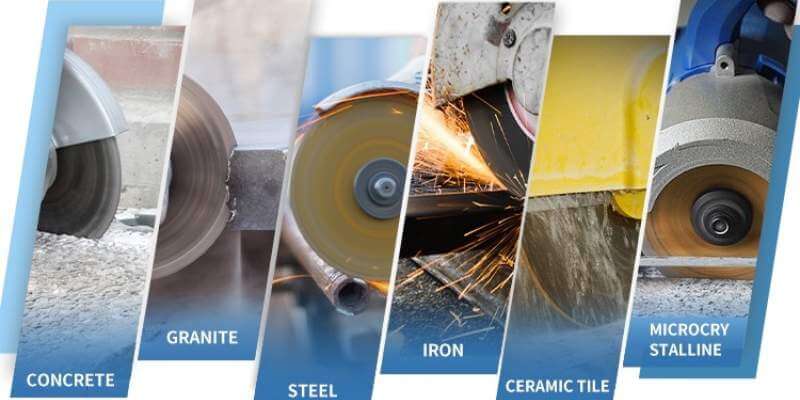
Today we're going to talk about diamond saw blades and why there are some of the best concrete and asphalt circular saw blades on the market.
Diamond saw blades aren't made for cutting diamonds. They're made with diamonds. These blades are made from high-quality steel.Additionally, the blade actually has diamonds embedded in it, as the name would imply.They're not the same diamonds found in engagement rings. These shiny gems are all synthetic. This allows for control over key characteristics such as crystal shape, size, and strength.

Now, before we get into how these blades work, let's look at a simple breakdown. A diamond blade is composed of three major parts, the core, the segment, and the gullets. The core is the central metal disk to which the segments of the blade are attached the stronger the attachment to this core, the stronger the blade. The segment is the primary element in cutting or grinding materials. It is a piece of metal with diamond bonds that is braised or welded to the core of a blade. The slots in the blade core known as gullets allow for quicker cooling. By enabling air or water to circulate between the segments, they do this. They also enable the blade to flex while being sliced. Despite being referred to as cutting tools, diamond blades are actually grinding instruments. The diamonds that are attached to the blade's edge are revealed as it turns and grind through the material.
Eventually, the exposed diamonds will fracture due to heat and pressure and will fall off the blade. But that's okay because these diamonds are embedded throughout the segment of the blade. New diamonds will be exposed as the blade is used.
Centering is the process of compressing powdered metal into a mold with so much force that it takes on the desired shape. Then the metal pieces are heated sometimes for days until the metal has bonded together.regarding diamond blades. To create a diamond-infused bond, man-made diamonds are dispersed among the metal powder.This bond varies between different levels of softness and hardness for each blade. That's because as the blade is used, the bond is designed to wear down and expose more and more of the diamonds. This way, the blade stays sharp and cuts better for longer.
The speed at which a bond wears down is just as important as choosing the blade itself. Often, the bond hardness is the opposite of the material to be cut.
For instance, porcelain, a very hard, less abrasive material needs to be cut with a soft bond. This allows for a specific rate of where to match the material being cut. If porcelain was cut with a hard bond, new diamonds would not be exposed and the blade wouldn't be doing its job.On the other hand, soft and abrasive materials like asphalt or concrete need to be cut with a hard blade to maintain the lifespan of the blade.Remember the opposite, attract.
comparing your material to the bond strength can help to figure out whether or not the blade will work for your job,but that's not the only thing that affects your cup.The use of the blade, or the type of cutting you're doing, is one of the most important things to take into account.for a segmented rim.
Provides a fast and rough cut. They're mainly used for concrete brick, masonry. and asphalt.
Can be used for dry or wet applications since the gullets or segments on the edge of the blade, allow for airflow and cooling of the blade core, the size and shape of the gullet vary from blade to blade and will largely depend on the type of material you're cutting.
For instance Multi-purpose played as anti-crack goal is to allow for enhanced safety while cutting steel and metal up to 5 millimeters thick, these keyhole shaped gullets result in less chipping of the material and reduce vibration levels which significantly decreases the risk of the blade core or cracking under even the harshest conditions.
Has scoop shaped gullet for faster removal of fine materials and increased cutting speed.
This mainly tpye of concrete diamond blade,asphalt diamond blade.
And other abrasive materials. As a general rule, the more abrasive the material, the wider the gullet should be to allow for better heat dissipation. The segment on this blade is also pretty unique. Its laser-welded core makes it stronger and longer lasting than the competition.
All three of these blades, the max cut multi-purpose, and duo asphalt are hard-to-bond blades. They do better at cutting softer materials.
Now, for a softer bond,Turbo blades like the arrow jet blade are excellent for cutting ceramic and stone tiles, granite, marble, and other very hard and dense materials, these blades are designed to cut fast in both wet and dry applications.
With the solid serrated cutting edge, they stay in constant contact with the material. They're cutting, producing a smoother cut than segmented blades. They have a long life and the combination of the serrated edge and the ventilated steel core provide better cooling during use.
It was cuts the slowest of the bunch, but also provides the best smoothest cut.Another soft bond blade, they're typically for ceramic diamond blades, porcelain diamond blades, marble diamond blades, and granite diamond blades, tile diamond blades
Continuous rim blades are most commonly referred to as wet-cut blades. This is because continuous rim blades like this classic blade, black, the gullets and holes the other blades use to dissipate heat. If there's nothing to lessen the heat, the blade won't last very long. That's why continuous rim blades are mostly used with water.
As the name implies, uses water to assist the blade and cut through thick tiles , reinforced concrete metal, bricks, and other masonries. Wet blades are less prone to overheating and blade wear. So they're often used for long continuous projects.
This method of cutting with water also reduces the respiratory risks and other health hazards caused by dust particles since the water also turns a lot of the dust particles from the cut into a slurry.
Is ideal for indoor use or in work areas where the presence of a water source is uncertain. In contrast with wet cutting, dry cutting is meant for intermittent and small-scale cutting. The main reason for this is that the blade needs ample airflow by allowing it to gradually spend to a stop between cuts. This reduces the risk of either the tool or the blade overheating. These blades are ideal for shaping, detailing, and finishing, though deep cuts can also be achieved with the proper cautionary measures.
If none of these diamond saw blades sound like they're up for the task, don't worry. We also have crack-chasing diamond saw blades, rescue diamond saw blades, and blades made to fit several different styles of saws and grinders.So the three things you need to remember when choosing a diamond saw blade are the material you're cutting, the type of rim you need, and whether you will be cutting wet or dry, that's it







